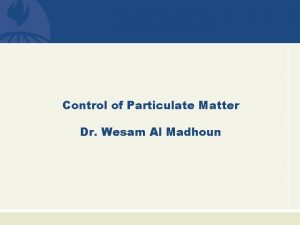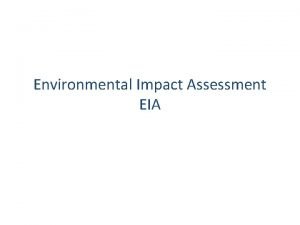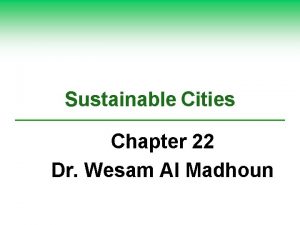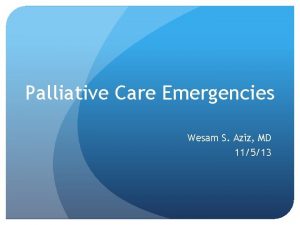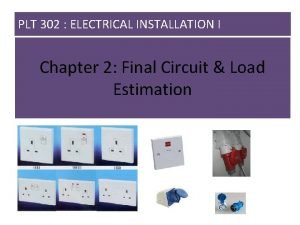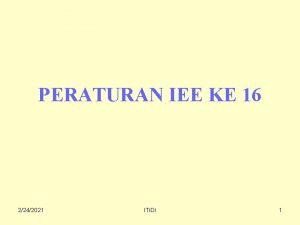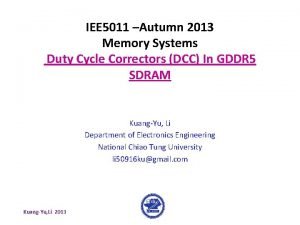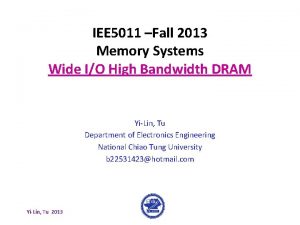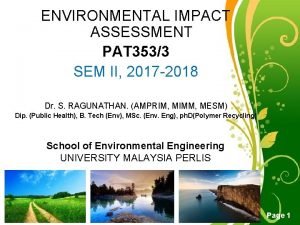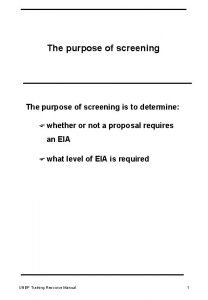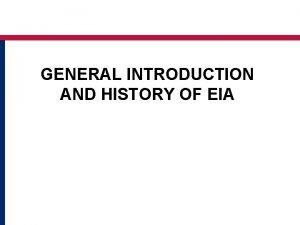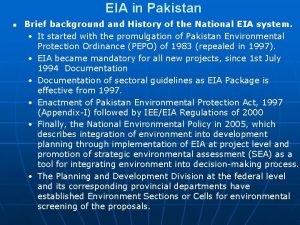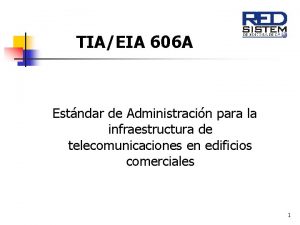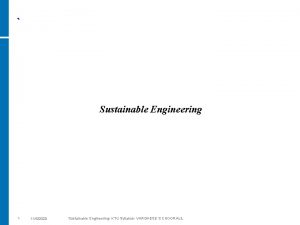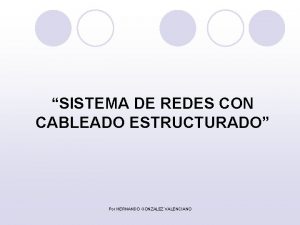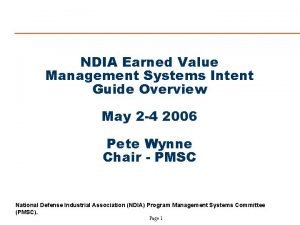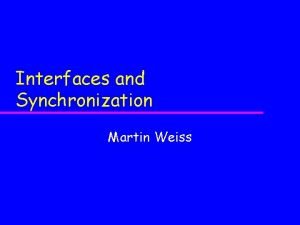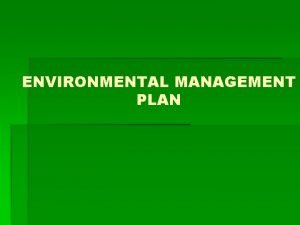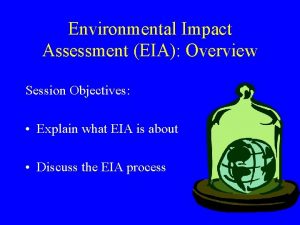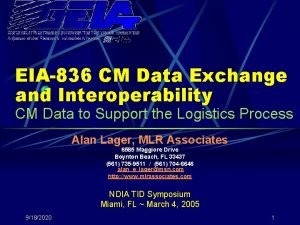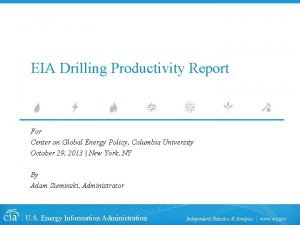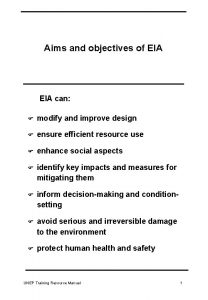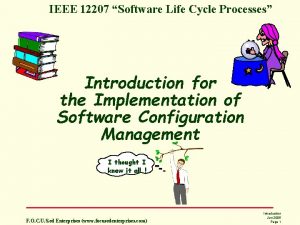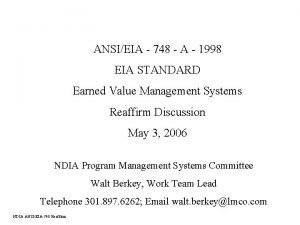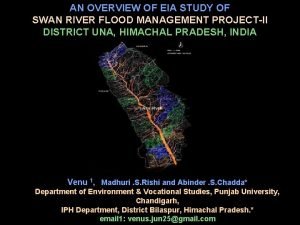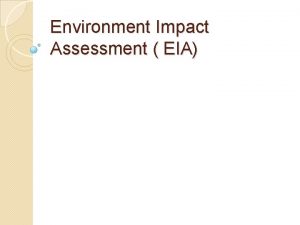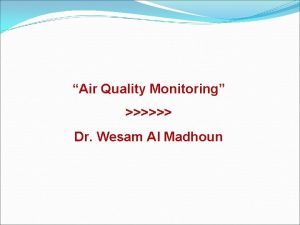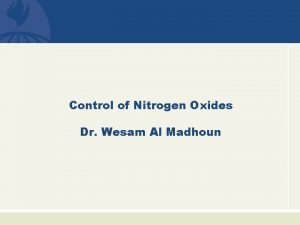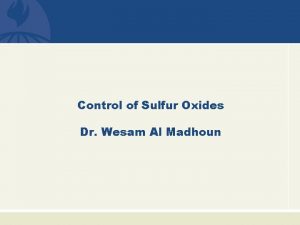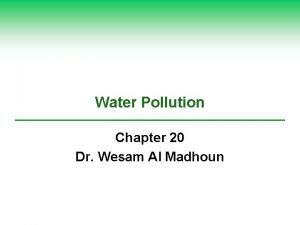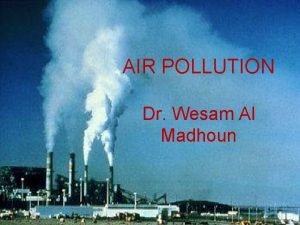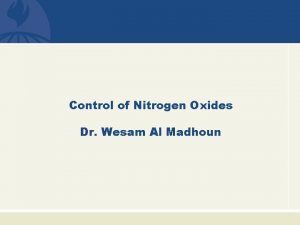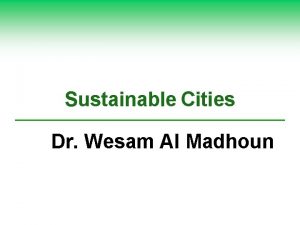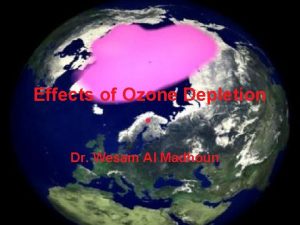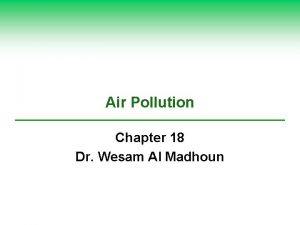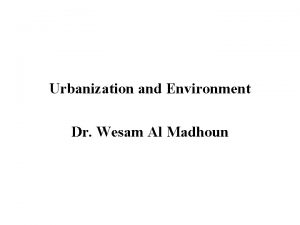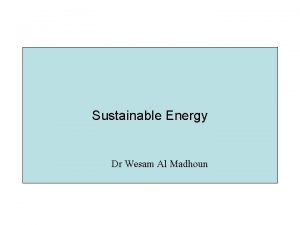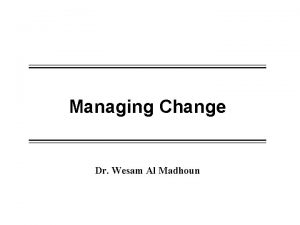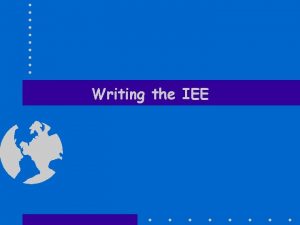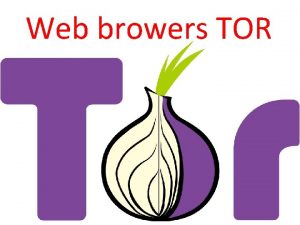EIA Process IEE TOR Dr Wesam Al Madhoun






























- Slides: 30

EIA Process, IEE, TOR Dr. Wesam Al Madhoun

The Environmental Impact Assessment Process è è è è Major steps in the EIA process are: Screening Initial Environmental Examination (IEE) Scoping Full-Scale Assessment EIA Review and Decision Making Monitoring and Follow-Up 2

Initial Environmental Examination (IEE) Screening Scoping/ Terms of Reference You are here Full-Scale EIA Review IEE Review EIA Required EIA Not Required EIA Approved Decision Making Monitoring EIA Audit and Evaluation EIA Not Approved Evaluate Options 3

Screening è It would be time consuming and a waste of resources for all proposed projects and activities to undergo EIA è Not all development projects require an EIA, as some projects may not pose an environmental threat è Screening is the process used to determine whether a proposed project or activity requires an EIA and, if so, what level of environmental review is necessary 4

Purpose è Identify those projects or activities that may cause potential significant impacts è Identify special conditions/analyses that may be required by international funding bodies è Categorize the project as one where: » Full-Scale EIA required » Some further environmental analysis required » No further environmental analysis required 5

Typical Proposals Requiring Full-Scale EIA è Infrastructure projects è Large-scale industrial activities è Resource extractive industries and activities è Waste management and disposal è Substantial changes in farming or fishing practices 6

Screening Techniques è Assessor or decision-maker discretion è Project lists with thresholds and triggers è Exclusion project lists è Preliminary or initial EIAs è Combination of these techniques 7

Screening Criteria » Screening criteria typically consider: è Project type, location, size (e. g. , capital investment, number of people affected, project capacity, areal extent) è Receiving environment characteristics è Strength of community opinion è Confidence in prediction of impacts 8

Project Location Requirements for screening: è The screening checklist should include a section on site location characteristics, including, at a minimum, the four categories of environmentally critical areas: » National Parks » Indigenous people’s area » Tourist area » Ecologically sensitive area 9

Project Location (Cont’d) è Site selection defines the location of the study area and the specific environmental resource base to be examined è Often the single most important factor contributing to a project’s potential negative impacts è Regional development plans should be used as guides to select project locations where environmental conditions will be minimally impacted 10

Example Project Screening Criteria from Thailand Type of Project 1. Infrastructure • Commercial Airport • Mass Transit System • Hotel or Resort 2. Agriculture and Natural Resources • Dam or Reservoir • Irrigation Threshold Scale All > 80 Rooms Location 4 Critical Areas >100 million cu. m. > 15 sq. km. 11

Example Project Screening Criteria from Thailand (Cont’d) Type of Project 3. Industrial and Power • Petrochemical Industry • Oil Refinery • Chlor-Alkaline Industry • Natural Gas Separation • Iron/Steel • Cement Industry • Smelting • Pulp Industry • Industrial Estates • Thermal Power Plants • Mining Threshold Scale Location > 100 tons/day (raw material) All 100 tons/day (output) 100 tons/day, batch All > 50 tons/day All > 10 megawatts All 12

Asian Development Bank (ADB) Screening Categories All Projects Category A Category B Category C Projects that typically require an EIA study Projects that typically require only an IEE Projects that typically do not require an IEE Examples: • Forest Industries • Water Impoundment • Industries Examples: • Renewable Energy • Aquaculture • Tourism Development • Infrastructure Rehabilitation Examples: • Forestry Research & Extension • Rural Health Services • Marine Sciences Education

Palestinian Law 14

Project Screening Flow Chart Project type on project screening checklist? NO YES Project scale above the screening threshold? NO Project located in a critical area? YES NO YES IAA funding, or any other special circumstances? Will the project be funded by an IAA? NO YES Get specific IAA requirements YES Prepare the work plan for the initial environmental examination (IEE) NO NO No initial environmental examination required (IEE)

Initial Environmental Examination (IEE) Screening Scoping/ Terms of Reference You are here Full-Scale EIA Review IEE Review EIA Required EIA Not Required EIA Approved Decision Making Monitoring EIA Audit and Evaluation EIA Not Approved Evaluate Options 16

Initial Environmental Examination Ø Initial environmental examination (IEE) is intended as a low-cost environmental evaluation that makes use of information already available 17

Purpose of IEE è Describes the proposed project or activity and examines alternatives è Identifies and addresses community concerns to extent possible è Identifies and assesses potential environmental effects è Directs future action 18

Objectives of IEE è Identify all potential environmental concerns relating to a proposed project or activity è Identify all significant environmental issues (SEIs) è Resolve simple SEIs è Develop the focus for follow-up studies based on unresolved SEIs 19

Possible IEE Outcomes 1. No requirement for further environmental study; proposal not anticipated to have significant impact. 2. Limited environmental study needed; environmental impacts are known and can be easily mitigated. 3. Full-scale EIA required; impacts unknown or likely to be significant. 20

IEE in the Overall EIA Process Project Screening Identifies projects that typically contain potential significant issues Full-Scale EIA or Other Additional Study Resolves any remaining significant environmental issues Initial Environmental Examination 1. Identifies potential significant environmental issues associated with a project 2. Grades effects and identifies actual Significant Environmental Issues (SEIs) 3. Resolves simple SEIs 4. Recommends further action for resolving outstanding SEIs

IEE Flow Chart 1. Identify Potential Significant Environmental Issues 2. Obtain Information 4. Resolve SEIs Where Possible (Review Alternatives/Develop Environmental Management Plans and Protection Measures) IEE is the final EIA Report, including: 1. SEIs 2. EPM 3. EMP YES 3. Effects Classification/ Identification of Significant Environmental Issues (SEIs) 5. Are all SEIs resolved? NO The IEE makes recommendations for further study: Full-Scale EIA

Identification of Potential Significant Issues 1. Identify valued environmental/ecosystem components (VECs) » Professional judgment/past experience » Legislative requirements » Stakeholder and community values 2. 3. Identify the potential for impacts to each VEC Identify potential for cumulative impacts (i. e. , to the site as a whole and to the region) 23

Commonly Considered VECs è Natural physical resources (e. g. , surface and groundwater, air, climate, soil) è Natural biological resources (e. g. , forests, wetlands, river and lake ecology) è Economic development resources (e. g. , agriculture, industry, infrastructure, tourism) Quality of life (e. g. , public health, socioeconomic, cultural, aesthetics) è è National commitments species protection) (e. g. , endangered 24

Methods for Identifying Potential Impacts to VECs è Matrices » Sectoral » Project type è Checklists è Professional expertise and experience with similar project types è Combination of techniques 25

Valued Env. Component (VEC) Development Projects Significant Impact Air Quality Seismology/Geology Erosion Land Quality Fisheries Forests Terrestrial Wildlife Noise Land Use Aesthetics Industries Resettlement Archaeological/Historical Public Health Socioeconomic Surface Water Quality Sectoral Matrix Example Ports and Harbours Airports Rapid Transit Highways Oil/Gas Pipelines Moderate - Significant Impact Insignificant Impact

Project Checklist Example Actions Affecting Resources and Values: Potential Damages: 1. Impairment of Other Beneficial 1. Disruption of Hydrology Water Uses 2. Resettlement 3. Encroachment on Precious 2. Social Inequities 3. Loss of these Values Ecology 4. Encroachment on Historic/ 4. Loss of these Values 5. Conflicts with Other Beneficial Cultural Values Water Uses 5. Cooling Tower Obstruction 6. Regional Flooding Hazard 6. Hazard to Plant Operations 7. Waste Emissions Related to 7. Intensification of Problems of Pollution Control Siting EIA Procedures and Decision Making 27

Considerations in Determining Potential Effects è Impacts to: » individual VECs » entire site (i. e. , impacts to all VECs combined) » cumulative impacts to the area (i. e. , considering other existing and planned projects) è Impacts from all phases of the project (i. e. , construction, operation, decommissioning) è Impacts on different time-scales Impacts from different orders of impact è 28

Orders of Impact Example River Embankment First Order Second Order Third Order Fourth Order Dry Flood Plains Loss of Plain Fisheries Loss of Fisheries Income Social Tension and Poverty Intensified

Data Requirements è Project » Type » Size » Location è Area of potential impact » Physical resources » Biological resources » Economic development resources » Quality of life » Other existing and planned projects 30
 Wesam al madhoun
Wesam al madhoun Difference between eia and iee
Difference between eia and iee Wesam food menu
Wesam food menu Fiberpharm
Fiberpharm Ckt motor perlis
Ckt motor perlis Ujian keselanjaran pengalir perlindungan
Ujian keselanjaran pengalir perlindungan Iee
Iee Iee code of practice
Iee code of practice Iso 829
Iso 829 Iee
Iee Wide io
Wide io Eia process
Eia process Eia process flowchart
Eia process flowchart History of eia
History of eia Eia process in pakistan
Eia process in pakistan Tia/eia 606-a
Tia/eia 606-a Sustainable engineering ktu
Sustainable engineering ktu Ansi/tia/eia-606-a
Ansi/tia/eia-606-a Earned value management systems eia-748-c intent guide
Earned value management systems eia-748-c intent guide Eia-232-d
Eia-232-d Environmental management plan in eia
Environmental management plan in eia Methods of eia
Methods of eia Evolution of eia
Evolution of eia Ansi eia 836
Ansi eia 836 Eia drilling productivity
Eia drilling productivity Eia-632
Eia-632 Characteristics of eia team
Characteristics of eia team Frigorous
Frigorous Ieee 12207
Ieee 12207 Ansi/eia-748
Ansi/eia-748 Eia swan river
Eia swan river
